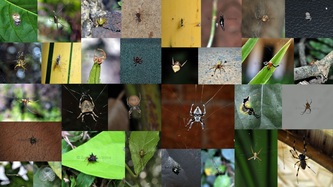Spiders are ancient creatures with a history going back over 350 million years. They are abundant and widespread in almost all ecosystems and constitute one of the most important components of global biodiversity. Spiders have even greater importance rather than being an exclusive predator. They feed on pests like cockroaches, silverfishes, mosquitoes etc. They are also known to control the pests in different agro ecosystems. Although there are more than 1400 species of spiders described from India, the study on spiders is still in its grass root level.
It all started as a mere statement when I visited ARRS back in October 2010. Neeti Mahesh was one of those people who were really interested in spiders and who gave the idea of creating this basic inventory on spiders found in and around ARRS.
After a few months, I decided to sit down and write a proposal to ARRS to get the permission to carry out the Spider checklist study. Fortunately, I got the permission to carry out the study, even though I’m a rookie in it.
I and my friend Gokul Vinayan decided to kick start the study by being on the field for a week. We reached at Agumbe (ARRS) on 22nd morning and started our work on the field.
Spider diversity varies by seasons, ie. Dominancy of spider species in a particular environment changes by season. Certain species of spiders are found during the summer in a particular environment, while some other species are dominant during the monsoons or winter.
We decided to use this 5 days on field to spot and identify the dominant or common species that are found in plenty during this time of the year, in and around ARRS. With plenty of help from ARRS team (especially Naren Sreenivasan) we could identify over 30 species of spiders in less than 5 days of time. In order to get the complete number of spiders found in and around Agumbe, it is needed to carry out this study throughout the year.
We have planned to come back and improve on this checklist study after a few months, which will be the start of the monsoons in Agumbe, forcing different species of spiders to occupy the environment.
It all started as a mere statement when I visited ARRS back in October 2010. Neeti Mahesh was one of those people who were really interested in spiders and who gave the idea of creating this basic inventory on spiders found in and around ARRS.
After a few months, I decided to sit down and write a proposal to ARRS to get the permission to carry out the Spider checklist study. Fortunately, I got the permission to carry out the study, even though I’m a rookie in it.
I and my friend Gokul Vinayan decided to kick start the study by being on the field for a week. We reached at Agumbe (ARRS) on 22nd morning and started our work on the field.
Spider diversity varies by seasons, ie. Dominancy of spider species in a particular environment changes by season. Certain species of spiders are found during the summer in a particular environment, while some other species are dominant during the monsoons or winter.
We decided to use this 5 days on field to spot and identify the dominant or common species that are found in plenty during this time of the year, in and around ARRS. With plenty of help from ARRS team (especially Naren Sreenivasan) we could identify over 30 species of spiders in less than 5 days of time. In order to get the complete number of spiders found in and around Agumbe, it is needed to carry out this study throughout the year.
We have planned to come back and improve on this checklist study after a few months, which will be the start of the monsoons in Agumbe, forcing different species of spiders to occupy the environment.


 RSS Feed
RSS Feed
